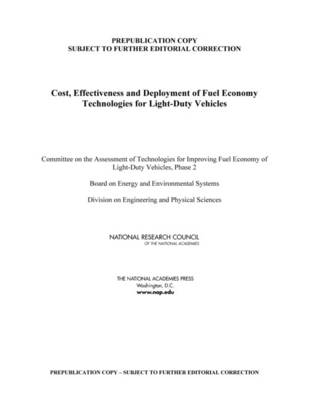
Cost, Effectiveness, and Deployment of Fuel Economy Technologies for Light-Duty Vehicles
National Academies Press (Verlag)
978-0-309-37388-3 (ISBN)
- Keine Verlagsinformationen verfügbar
- Artikel merken
Written to inform The United States Department of Transportation's National Highway Traffic Safety Administration (NHTSA) and Environmental Protection Agency (EPA) Corporate Average Fuel Economy (CAFE) and greenhouse gas (GHG) emission standards, this new report from the National Research Council is a technical evaluation of costs, benefits, and implementation issues of fuel reduction technologies for next-generation light-duty vehicles. Cost, Effectiveness, and Deployment of Fuel Economy Technologies for Light-Duty Vehicles estimates the cost, potential efficiency improvements, and barriers to commercial deployment of technologies that might be employed from 2020 to 2030. This report describes these promising technologies and makes recommendations for their inclusion on the list of technologies applicable for the 2017-2025 CAFE standards.
Table of Contents
Front Matter
Summary
1 Introduction
2 Technologies for Reducing Fuel Consumption in Spark-Ignition
Engines
3 Technologies for Reducing Fuel Consumption in
Compression-Ignition Diesel Engines
4 Electrified Powertrains
5 Transmissions
6 Non-Powertrain Technologies
7 Cost and Manufacturing Considerations for Meeting Fuel Economy
Standards
8 Estimates of Technology Costs and Fuel Consumption Reduction
Effectiveness
9 Consumer Impacts and Acceptance Issues
10 Overall Assessment of CAFE Program Methodology and Design
Appendix A: Statement of Task
Appendix B: Committee Biographies
Appendix C: Presentations and Committee Meetings
Appendix D: Ideal Thermodynamic Cycles for Otto, Diesel, and
Atkinson Engines
Appendix E: SI Engine Definitions and Efficiency Fundamentals
Appendix F: Examples of Friction Reduction Opportunities for Main
Engine Components
Appendix G: Friction Reduction in Downsized Engines
Appendix H: Variable Valve Timing Systems
Appendix I: Variable Valve Lift Systems
Appendix J: Reasons for Potential Differences from NHTSA Estimates
for Fuel Consumption Reduction Effectiveness of Turbocharged,
Downsized Engines
Appendix K: DOE Research Projects on Turbocharged and Downsized
Engines
Appendix L: Relationship between Power and Performance
Appendix M: HCCI Projects
Appendix N: Effect of Compression Ratio of Brake Thermal Efficiency
Appendix O: Variable Compression Ratio Engines
Appendix P: Fuel Consumption Impact of Tier 3 Emission Standards
Appendix Q: Examples of EPA's Standards for Gasoline
Appendix R: Impact of Low Carbon Fuels to Achieve Reductions in GHG
Emissions (California LCFS 2007 Alternative Fuels and Cleaner
Fossil Fuels CNG, LPG)
Appendix S: NHTSA's Estimated Fuel Consumption Reduction
Effectiveness of Technologies and Estimated Costs of Technologies
Appendix T: Derivation of Turbocharged, Downsized Engine Direct
Manufacturing Costs
Appendix U: SI Engine Pathway NHTSA Estimates Direct Manufacturing
Costs and Total Costs
Appendix V: SI Engine Pathway NRC Estimates Direct Manufacturing
Costs Alternative Pathway, Alternative High CR with Exhaust
Scavenging, and Alternative EVAS Supercharger
Appendix W: Technologies, Footprints, and Fuel Economy for Example
Passenger Cars, Trucks, and Hybrid Passenger Cars
Appendix X: Full System Simulation Modeling of Fuel Consumption
Reductions
Appendix Y: Acronym List
1 Front Matter; 2 Summary; 3 1 Introduction; 4 2 Technologies for Reducing Fuel Consumption in Spark-Ignition Engines; 5 3 Technologies for Reducing Fuel Consumption in Compression-Ignition Diesel Engines; 6 4 Electrified Powertrains; 7 5 Transmissions; 8 6 Non-Powertrain Technologies; 9 7 Cost and Manufacturing Considerations for Meeting Fuel Economy Standards; 10 8 Estimates of Technology Costs and Fuel Consumption Reduction Effectiveness; 11 9 Consumer Impacts and Acceptance Issues; 12 10 Overall Assessment of CAFE Program Methodology and Design; 13 Appendix A: Statement of Task; 14 Appendix B: Committee Biographies; 15 Appendix C: Presentations and Committee Meetings; 16 Appendix D: Ideal Thermodynamic Cycles for Otto, Diesel, and Atkinson Engines; 17 Appendix E: SI Engine Definitions and Efficiency Fundamentals; 18 Appendix F: Examples of Friction Reduction Opportunities for Main Engine Components; 19 Appendix G: Friction Reduction in Downsized Engines; 20 Appendix H: Variable Valve Timing Systems; 21 Appendix I: Variable Valve Lift Systems; 22 Appendix J: Reasons for Potential Differences from NHTSA Estimates for Fuel Consumption Reduction Effectiveness of Turbocharged, Downsized Engines; 23 Appendix K: DOE Research Projects on Turbocharged and Downsized Engines; 24 Appendix L: Relationship between Power and Performance; 25 Appendix M: HCCI Projects; 26 Appendix N: Effect of Compression Ratio of Brake Thermal Efficiency; 27 Appendix O: Variable Compression Ratio Engines; 28 Appendix P: Fuel Consumption Impact of Tier 3 Emission Standards; 29 Appendix Q: Examples of EPA's Standards for Gasoline; 30 Appendix R: Impact of Low Carbon Fuels to Achieve Reductions in GHG Emissions (California LCFS 2007 Alternative Fuels and Cleaner Fossil Fuels CNG, LPG); 31 Appendix S: NHTSA's Estimated Fuel Consumption Reduction Effectiveness of Technologies and Estimated Costs of Technologies; 32 Appendix T: Derivation of Turbocharged, Downsized Engine Direct Manufacturing Costs; 33 Appendix U: SI Engine Pathway NHTSA Estimates Direct Manufacturing Costs and Total Costs; 34 Appendix V: SI Engine Pathway NRC Estimates Direct Manufacturing Costs Alternative Pathway, Alternative High CR with Exhaust Scavenging, and Alternative EVAS Supercharger; 35 Appendix W: Technologies, Footprints, and Fuel Economy for Example Passenger Cars, Trucks, and Hybrid Passenger Cars; 36 Appendix X: Full System Simulation Modeling of Fuel Consumption Reductions; 37 Appendix Y: Acronym List
| Verlagsort | Washington |
|---|---|
| Sprache | englisch |
| Maße | 216 x 279 mm |
| Themenwelt | Technik ► Elektrotechnik / Energietechnik |
| Technik ► Fahrzeugbau / Schiffbau | |
| ISBN-10 | 0-309-37388-3 / 0309373883 |
| ISBN-13 | 978-0-309-37388-3 / 9780309373883 |
| Zustand | Neuware |
| Haben Sie eine Frage zum Produkt? |
aus dem Bereich


